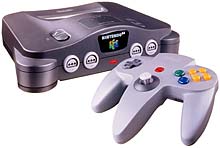 |
The Nintendo 64:
A PostmortemHere,
on the eve of the release of the Nintendo GameCube, we
take a look back at Nintendo’s previous system, the
Nintendo 64. Unlike the PlayStation, which still sees
releases to this day, the release of GameCube officially
signifies the death of the Nintendo 64, though the
critics may note that the titles slowed to a trickle some
time ago and the cynics may argue the system was dead on
arrival. Nintendo 64 never ruled the world, but it
wasn’t an utter failure, either. Nintendo won
generation two (NES) and generation three (SNES) the
victor of generation four was clearly Sony. History has a
bad habit of poking fun at anyone who didn’t
“win”, so where does that leave the Nintendo
64?
|
The Nintendo 64 is a conundrum. A
paradoxical piece of hardware, it was neither a very successful
system, nor was it a complete failure. It neither won the fourth
generation console war (that clearly went to the Sony
PlayStation), nor did it lose (that prize went to the Sega
Saturn). It never had that many games – more games will
probably come out in the final year of the PlayStation than came
out within the five year life of the Nintendo 64 – yet it
was home to some of the best and most exclusive games ever. While
PC Gamers can partake in Final Fantasy VII and Metal
Gear Solid, only Nintendo 64 owners can lay claim to Super
Mario 64, The Legend of Zelda: Ocarina of Time, and Goldeneye
007. Ultimately, the Nintendo 64’s legacy will be that
of a promising yet flawed console whose achievements will be
overshadowed by its shortcomings.
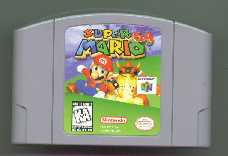 Clearly, the biggest
liability and fallacy of the Nintendo 64 was the fact that it was
a cartridge-based system. With the exception of handheld systems,
it will likely be the last cartridge based console. In a way,
this is sad – the end of an era that began in the 70’s
with the Atari 2600. The cartridge served a number of advantages.
Functionally, it offered no “load times”, which is an
issue with CD-based systems. Less of a problem today, it was a
huge liability for first-generation CD systems. Another advantage
is durability – cartridges are tougher and last longer than
CD’s. Logistically, cartridges are easier to copy-protect
– anyone with a CD burner can back up a PlayStation game. In
addition, cartridges afforded Nintendo control over the
manufacturing, content and price – even if a 3rd
party game doesn’t sell, Nintendo makes a killing on the
money they charged the publisher to purchase the cartridges to put
the game on.
Clearly, the biggest
liability and fallacy of the Nintendo 64 was the fact that it was
a cartridge-based system. With the exception of handheld systems,
it will likely be the last cartridge based console. In a way,
this is sad – the end of an era that began in the 70’s
with the Atari 2600. The cartridge served a number of advantages.
Functionally, it offered no “load times”, which is an
issue with CD-based systems. Less of a problem today, it was a
huge liability for first-generation CD systems. Another advantage
is durability – cartridges are tougher and last longer than
CD’s. Logistically, cartridges are easier to copy-protect
– anyone with a CD burner can back up a PlayStation game. In
addition, cartridges afforded Nintendo control over the
manufacturing, content and price – even if a 3rd
party game doesn’t sell, Nintendo makes a killing on the
money they charged the publisher to purchase the cartridges to put
the game on.
However, cartridges bought higher costs,
which irked consumers. Plus, game developers fell in love with
the idea of having tons of CD-ROM space to play with, so even
getting developers to write for the Nintendo 64 was
tricky. Nintendo realized this and they figured that the strength
of their first and second party titles would be sufficient.
Nintendo itself is hands down the single best game developer in
the world, so the idea almost worked. Having a Nintendo 64
means having access to some of the best games in the world, but
owning a PlayStation means having access to tons of games,
many at reasonable prices.
The copy protection advantage became a
liability when a working Nintendo 64 emulator named UltraHLE was
released in 1999. At the time the largest cartridge was roughly
32MB in size – smaller than most PC game demos, so their
trade over the Internet was easy.
In Nintendo’s defense, when the
cartridge vs. CD decision had to be made to that point every
CD based system had failed on the market. Sega CD, Turbo Graphix
CD, Amiga CD32, Phillips CD-i, Sega CDX, Jaguar CD and the 3DO
(though this last one did enjoy a brief flirtation with success).
Even the Sega Saturn, a direct competitor to the Nintendo 64,
failed. Since the success of the Sega Dreamcast is arguable given
the system’s quick demise and the ultimate success of the
PlayStation 2 and future consoles is up in the air, the Sony
PlayStation is the only successful CD-based console in
history. Couple this with the Nintendo/Sony fiasco (wherein Sony
gave Nintendo the run-around concerning a SNES CD add-on,
eventually turning it into the PlayStation), and it is easy to
see why Nintendo made the decision it did.
 Nintendo’s second greatest liability was Nintendo
itself. Nintendo is the self-proclaimed “Disney” of the
gaming world. They marketed children’s games at children in
the 1980’s, and like a good corporation they attacked the
late 90’s in the same way – failing to take into
account that the same gamers they got in the 80’s have now
grown up. It’s not really so much that there are not any
young gamers, but rather that the whole industry matured and
Nintendo failed to grow with it.
Nintendo’s second greatest liability was Nintendo
itself. Nintendo is the self-proclaimed “Disney” of the
gaming world. They marketed children’s games at children in
the 1980’s, and like a good corporation they attacked the
late 90’s in the same way – failing to take into
account that the same gamers they got in the 80’s have now
grown up. It’s not really so much that there are not any
young gamers, but rather that the whole industry matured and
Nintendo failed to grow with it.
To this end, Nintendo was restrictive as to
its content to the point where an “M” rated game was
rare – most games had to be tamed down in order to be on the
system. The most notorious example was Carmageddon, a game
whose main draw was hitting and killing innocent pedestrians.
Nintendo forced the developer to change the people to zombies and
essentially made the game pointless. In a vain attempt to change
their image at the last minute the Rare-developed Conker:
Twelve Tales was re-tooled and released as the M-rated game Conker’s
Bad Fur Day wherein the overly cute squirrel was changed to a
beer drinking, swearing, peeing-for distance protagonist. This
maneuver was greeted with poor sales.
Nintendo’s final liability was Pokémon
and a general smug apathy the Big “N” felt towards the
Nintendo 64. Nintendo believed strongly in the Nintendo 64 in
1994, funding it with ad campaigns and even quickly ditching
their fledgling Virtual Boy product before it (arguably) had a
chance. However, in 1997-1998 when it became clear that Pokémon
on the Game Boy was going to be Nintendo’s license to print
money, their support for the Nintendo 64 waned. This may in fact
be Nintendo as a company’s greatest liability, since it
tarnished the Nintendo brand name in the eyes of the gamers who
bought a Nintendo 64 in the hopes that more and better games
would be forthcoming.
The Nintendo 64’s legacy will be noted
for what it brought to the table:
The Good
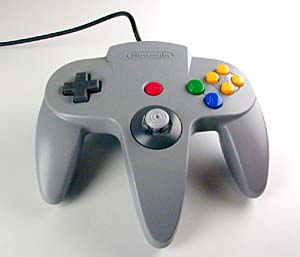 The
Analog Stick – While Saturn and the
PlayStation brought it in later as an option, the
Nintendo 64 controller had an analog stick from day one.
Nintendo innovates, the industry copies. The
Analog Stick – While Saturn and the
PlayStation brought it in later as an option, the
Nintendo 64 controller had an analog stick from day one.
Nintendo innovates, the industry copies. |
|
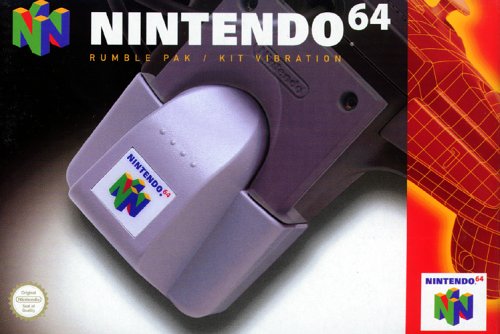 Force
Feedback – The “rumble pack”
brought force feedback to the home console. In a way, it
is indicative of Nintendo’s thinking. While
Microsoft and others put together $150 joysticks with
complex forces, Nintendo said “nah, just put a
thingy that shakes on it…” Force
Feedback – The “rumble pack”
brought force feedback to the home console. In a way, it
is indicative of Nintendo’s thinking. While
Microsoft and others put together $150 joysticks with
complex forces, Nintendo said “nah, just put a
thingy that shakes on it…”
|
|
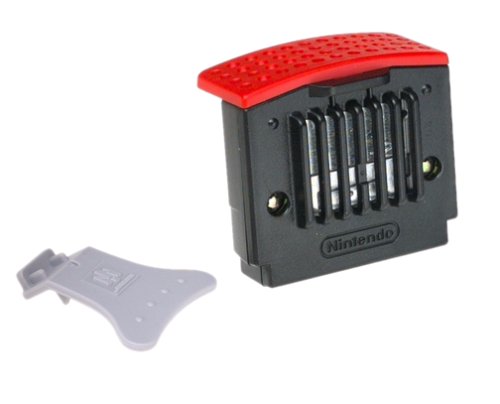 Memory
Expansion Pack – One of the few instances of a
company using its options, Nintendo designed the Nintendo
64 with a memory expansion slot. Originally the plan was
to package a memory upgrade with the 64DD, but when that
upgrade was pushed back to (eventually) 1999 in Japan and
was never released in the States, Nintendo decided to
release the expansion separately in the U.S. when
developers planned to develop for it and third party
hardware companies planned to release their own versions.
The Nintendo 64 shipped with 4MB of RAM, and the
expansion upped that to 8MB. In comparison, the
PlayStation only ever had 2MB. Developers used the pack
to improve frame rates and boost resolutions. Memory
Expansion Pack – One of the few instances of a
company using its options, Nintendo designed the Nintendo
64 with a memory expansion slot. Originally the plan was
to package a memory upgrade with the 64DD, but when that
upgrade was pushed back to (eventually) 1999 in Japan and
was never released in the States, Nintendo decided to
release the expansion separately in the U.S. when
developers planned to develop for it and third party
hardware companies planned to release their own versions.
The Nintendo 64 shipped with 4MB of RAM, and the
expansion upped that to 8MB. In comparison, the
PlayStation only ever had 2MB. Developers used the pack
to improve frame rates and boost resolutions.
|
|
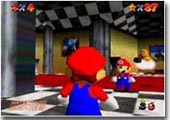 The Third
Person Platform Genre – Super Mario 64
jumped headlong into the rarely-entered and even more
rarely-well done 3rd person genre and
reinvented it. Some entries from developer Rare have come
close, bit no game has nailed the genre like Super
Mario 64. Ultimately, though, the game was the result
of two years of work and came to be known as a one-trick
pony of sorts. The Third
Person Platform Genre – Super Mario 64
jumped headlong into the rarely-entered and even more
rarely-well done 3rd person genre and
reinvented it. Some entries from developer Rare have come
close, bit no game has nailed the genre like Super
Mario 64. Ultimately, though, the game was the result
of two years of work and came to be known as a one-trick
pony of sorts.
|
|
 The Multiplayer FPS on a
Non-Networked Console – Goldeneye 007 was
an effective FPS on a console. That’s significant. Goldeneye
007 was a successful game whose licensed movie had
been available on home video for more than a year.
That’s even more significant. Goldeneye 007
was an effective multiplayer FPS on a system with no
network capabilities. That’s amazing, though less so
today than in 1997 when the game was quietly released.
Nintendo’s attitude again: The Multiplayer FPS on a
Non-Networked Console – Goldeneye 007 was
an effective FPS on a console. That’s significant. Goldeneye
007 was a successful game whose licensed movie had
been available on home video for more than a year.
That’s even more significant. Goldeneye 007
was an effective multiplayer FPS on a system with no
network capabilities. That’s amazing, though less so
today than in 1997 when the game was quietly released.
Nintendo’s attitude again:
“How do we do
multiplayer?”
“Just put them on different sections of the
screen.”
“But you can see what everyone else is doing.”
“You wont be looking at what other people are doing,
you’ll be looking at your own section!"
Besides, it did get rid of campers.
|
|
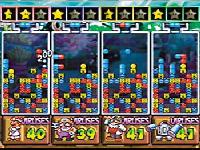 The Party Game –
akin to Goldeneye, the Nintendo 64’s four
controller ports lend itself to party games, most notably
for a four-player version of Tetris and the Mario
Party trilogy. The PlayStation could do with eight
players with extra hardware, but since that was never a
given most developers didn’t develop for it. The Party Game –
akin to Goldeneye, the Nintendo 64’s four
controller ports lend itself to party games, most notably
for a four-player version of Tetris and the Mario
Party trilogy. The PlayStation could do with eight
players with extra hardware, but since that was never a
given most developers didn’t develop for it.
|
|
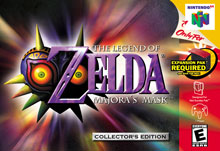 Strong Sequels
– The Legend of Zelda: Ocarina of Time took
four years to develop. The Legend of Zelda:
Majora’s Mask took two. Engine development time
aside, who would have thought it would be as solid if not
a better game than its predecessor? Camelot keeps belting
out solid Nintendo-licensed titles – Mario Golf,
Mario’s Tennis, also on the Game Boy Color.
How in the hell are these things consistently good?
Nintendo itself put out three Mario Party games in
as many years, each one one-upping the previous by a huge
margin, if a little repetitive. The game development
community could learn a thing or two from how Nintendo
keeps doing it. Strong Sequels
– The Legend of Zelda: Ocarina of Time took
four years to develop. The Legend of Zelda:
Majora’s Mask took two. Engine development time
aside, who would have thought it would be as solid if not
a better game than its predecessor? Camelot keeps belting
out solid Nintendo-licensed titles – Mario Golf,
Mario’s Tennis, also on the Game Boy Color.
How in the hell are these things consistently good?
Nintendo itself put out three Mario Party games in
as many years, each one one-upping the previous by a huge
margin, if a little repetitive. The game development
community could learn a thing or two from how Nintendo
keeps doing it.
|
The Bad
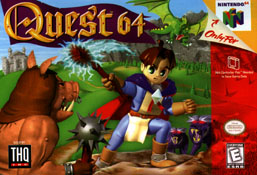 Few RPG’s –
Longtime developer Square, whose first six Final
Fantasy games had always graced Nintendo hardware,
decided to develop for Sony instead, due mainly to the
CD-ROM storage option. Since Final Fantasy is its
own religion of sorts in Japan, this helped to lead to
Sony’s dominance in that region. In fact, the sheer
reluctance of developers to write Nintendo 64 RPG’s
led to the system’s demise in Japan. The Japanese love
RPG’s, and even the Sega Saturn had a larger market
share in Japan (even after Sega dropped the console in
the U.S.) before Zelda was released, which helped
the Nintendo 64’s market share, but did not
“save” the console in Japan. Few RPG’s –
Longtime developer Square, whose first six Final
Fantasy games had always graced Nintendo hardware,
decided to develop for Sony instead, due mainly to the
CD-ROM storage option. Since Final Fantasy is its
own religion of sorts in Japan, this helped to lead to
Sony’s dominance in that region. In fact, the sheer
reluctance of developers to write Nintendo 64 RPG’s
led to the system’s demise in Japan. The Japanese love
RPG’s, and even the Sega Saturn had a larger market
share in Japan (even after Sega dropped the console in
the U.S.) before Zelda was released, which helped
the Nintendo 64’s market share, but did not
“save” the console in Japan. |
|
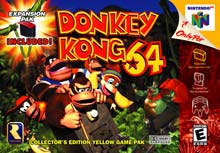 Segmented User Base
– There’s a reason few add-ons are released
– they will never sell as well as the base hardware,
and then the user base is divided into the have and the
have-nots. The 64DD threatened to do this, which is why
it wasn’t released in the United States, where the
Nintendo 64 had fared better. Nintendo tried bravely to
keep the memory expansion pack from segmenting the user
base – it only released games that used it
optionally at first. However Nintendo irked consumers
when it announced that not only would Donkey Kong 64
require the pack, it would come with a pack in the game
box. Since they would not release a second version
without the pack (so as to not confuse less informed
consumers who would gravitate to the less expensive
version), anyone who had purchased the $30 expansion pack
previously had wasted their money. To confuse matter
further, Perfect Dark, the “sequel” to Goldeneye
007, required the expansion pack to play in single
player mode – only the multiplayer mode would work
without it. Segmented User Base
– There’s a reason few add-ons are released
– they will never sell as well as the base hardware,
and then the user base is divided into the have and the
have-nots. The 64DD threatened to do this, which is why
it wasn’t released in the United States, where the
Nintendo 64 had fared better. Nintendo tried bravely to
keep the memory expansion pack from segmenting the user
base – it only released games that used it
optionally at first. However Nintendo irked consumers
when it announced that not only would Donkey Kong 64
require the pack, it would come with a pack in the game
box. Since they would not release a second version
without the pack (so as to not confuse less informed
consumers who would gravitate to the less expensive
version), anyone who had purchased the $30 expansion pack
previously had wasted their money. To confuse matter
further, Perfect Dark, the “sequel” to Goldeneye
007, required the expansion pack to play in single
player mode – only the multiplayer mode would work
without it.
|
|
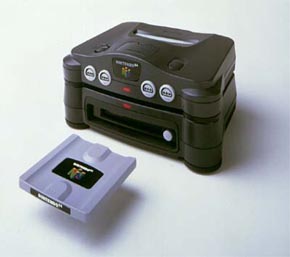 The 64DD Fiasco
– The Lewinsky of the Nintendo 64, the 64DD flopped
in Japan with its nine titles and never saw the light of
day in the U.S. When the Nintendo 64 was nearing release
in 1995, the cartridge was looking more and more like an
impending liability. Nintendo decided to tell the press
that the then-titled Ultra 64 would have a CD-ROM drive
add-on a few months after launch. By 1996, when the
Nintendo 64 was delayed for what would be another year,
the plan was for a “bulky drive” – a large
removable rewritable magnetic disk. Dubbed the 64DD, it
was to be a 64MB disk, in keeping with the “64”
theme (Super Mario 64, by comparison, was 8MB),
and whose main selling point was a rewritable portion.
Taking the concept further than a memory card could, this
meant that games could be customizable. Some games
shipped with 64DD “hooks” – F-Zero X
for example, allowed for a track editor add-on disk.
However, the 64DD fell victim to the add-on curse in
development. It suffered numerous delays – so much
so that numerous games kept getting squeezed onto
cartridges. Plus, as happened with the Famicom Disk
System (The 64DD of the Famicom, the NES in Japan),
before long cartridges could hold as much data as a 64DD
disk, making the storage capacity argument moot. The
system was dead in the water when it was finally released
in Japan in December 1999, over 4 years after the initial
release of the Nintendo 64 in that country. The 64DD Fiasco
– The Lewinsky of the Nintendo 64, the 64DD flopped
in Japan with its nine titles and never saw the light of
day in the U.S. When the Nintendo 64 was nearing release
in 1995, the cartridge was looking more and more like an
impending liability. Nintendo decided to tell the press
that the then-titled Ultra 64 would have a CD-ROM drive
add-on a few months after launch. By 1996, when the
Nintendo 64 was delayed for what would be another year,
the plan was for a “bulky drive” – a large
removable rewritable magnetic disk. Dubbed the 64DD, it
was to be a 64MB disk, in keeping with the “64”
theme (Super Mario 64, by comparison, was 8MB),
and whose main selling point was a rewritable portion.
Taking the concept further than a memory card could, this
meant that games could be customizable. Some games
shipped with 64DD “hooks” – F-Zero X
for example, allowed for a track editor add-on disk.
However, the 64DD fell victim to the add-on curse in
development. It suffered numerous delays – so much
so that numerous games kept getting squeezed onto
cartridges. Plus, as happened with the Famicom Disk
System (The 64DD of the Famicom, the NES in Japan),
before long cartridges could hold as much data as a 64DD
disk, making the storage capacity argument moot. The
system was dead in the water when it was finally released
in Japan in December 1999, over 4 years after the initial
release of the Nintendo 64 in that country.
|
|
 Same-Old, Same-Old
– Since the Nintendo 64 didn’t have that many
games, many of them fell into a familiar rut. Oh goody!
Another racing game! Oh goody! Another Mario
clone! Other genres, like fighting games, were woefully
under-represented. Same-Old, Same-Old
– Since the Nintendo 64 didn’t have that many
games, many of them fell into a familiar rut. Oh goody!
Another racing game! Oh goody! Another Mario
clone! Other genres, like fighting games, were woefully
under-represented.
|
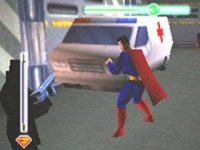 Bean Counter Mentality
– Superman, from developer Titus, was a horrible
game. But it sold well – which only tends to
encourage more crap. Mediocre games like Mission:
Impossible sold over half as many copies as Goldeneye
007. Whenever questioned early on about problems with
the Nintendo 64’s library content, Nintendo of
America president Howard Lincoln stated “What
problem? Look at these sales numbers…” Bean Counter Mentality
– Superman, from developer Titus, was a horrible
game. But it sold well – which only tends to
encourage more crap. Mediocre games like Mission:
Impossible sold over half as many copies as Goldeneye
007. Whenever questioned early on about problems with
the Nintendo 64’s library content, Nintendo of
America president Howard Lincoln stated “What
problem? Look at these sales numbers…” |
The Ugly
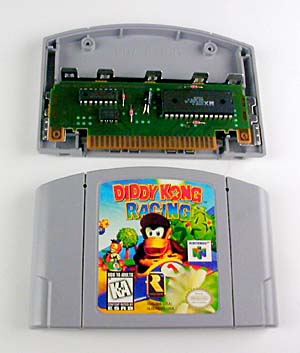 Nintendo’s
Cartridge Prices – Cartridges themselves
weren’t inherently evil, but they started to appear
that way should you take into account the dollar figures
attached to them. A cartridge based game cost the
developer/publish approximately $30-$35 to publish.
Obviously at that point the game has to retail at $55 or
more to pull a profit. Many games retailed at $70 on
their release day. Gamers didn’t take to this sort
of mentality, especially when PlayStation games were
debuting at $40-$50, with their CD based media costing
$2-$5 to make. Nintendo’s
Cartridge Prices – Cartridges themselves
weren’t inherently evil, but they started to appear
that way should you take into account the dollar figures
attached to them. A cartridge based game cost the
developer/publish approximately $30-$35 to publish.
Obviously at that point the game has to retail at $55 or
more to pull a profit. Many games retailed at $70 on
their release day. Gamers didn’t take to this sort
of mentality, especially when PlayStation games were
debuting at $40-$50, with their CD based media costing
$2-$5 to make.
At any mass scale
necessary to pull a significant profit, a publisher would
have to “bet the company” to spend enough money
to make enough cartridges to make a game a hit. Couple
this with the fact that the Nintendo 64 was simply not as
popular a console as the PlayStation and you begin to
understand why there weren’t too many Nintendo 64
games and why when they did show up in stores there
weren’t too many copies of them.
But the root of all of this
wasn’t necessarily in the price of solid state media
– true, cartridges cost more money to make than a CD
did but the real problem was Nintendo themselves. They
made a profit off of the cartridge itself. Then they made
money off of the license to make the game. Then they made
money off of royalties on the games when they did sell.
This abuse of a market was tolerable when there were no
alternatives, but as Nintendo started becoming the car
retailer of the game industry many developers decided to
take their games elsewhere.
|
|
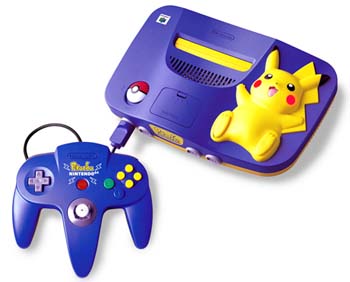 The
Pokémon Cash-In – A rumor started
circulating before E3 2001 that Nintendo had decided
that, had the GameCube not made an impressive showing
they were going to abandon it and go Game Boy all the
way. The hard facts are that the Nintendo 64 didn’t
make as much money for Nintendo as the Game Boy with
Pokémon, a ten-year-old platform, made in that same time
period. This naturally made for some tie-ins – the
easiest way to success is to leach off the success of
others. A quick buck was to be had with Pokémon Snap,
a game whose main goal was to take pictures of Pokémon.
That’s it. This was followed by the Pokémon
Stadium games and of course, there was I See You,
Pikachu!, a game where you “spoke” to a 3-D
Pikachu (the “cute yellow rat” Pokémon) using
a special microphone. Nintendo decided the toy factor of
this game merited an $89 price tag. All of this paled
however to the ultra-gay Pikachu Nintendo 64 with the
feet as buttons and cheeks for a power light. Scary The
Pokémon Cash-In – A rumor started
circulating before E3 2001 that Nintendo had decided
that, had the GameCube not made an impressive showing
they were going to abandon it and go Game Boy all the
way. The hard facts are that the Nintendo 64 didn’t
make as much money for Nintendo as the Game Boy with
Pokémon, a ten-year-old platform, made in that same time
period. This naturally made for some tie-ins – the
easiest way to success is to leach off the success of
others. A quick buck was to be had with Pokémon Snap,
a game whose main goal was to take pictures of Pokémon.
That’s it. This was followed by the Pokémon
Stadium games and of course, there was I See You,
Pikachu!, a game where you “spoke” to a 3-D
Pikachu (the “cute yellow rat” Pokémon) using
a special microphone. Nintendo decided the toy factor of
this game merited an $89 price tag. All of this paled
however to the ultra-gay Pikachu Nintendo 64 with the
feet as buttons and cheeks for a power light. Scary
|
|
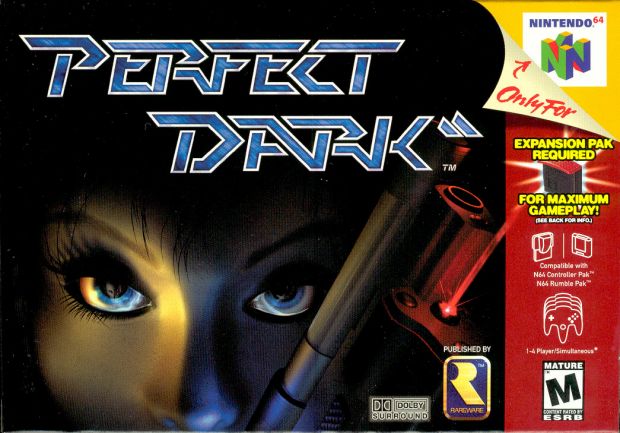 Delays
– The Nintendo 64 itself was delayed over a year.
Most of the important games saw delays. Perfect Dark
was delayed so long that the Nintendo 64 was no longer
even financially viable anymore (it missed Christmas 1999
by six months). Conker’s Bad Fur Day saw so
many delays it went through two title changes (Conker
64, Conker: Twelve Tales) and a change in motive
(meaning that the Game Boy game, aimed at Children, was
horribly misplaced). The Super Mario 64 sequel and
another Rare game, Dinosaur Planet, got themselves
delayed onto the next Nintendo home console, the
GameCube. Even Pokémon Stadium got delayed six
months, not because it wasn’t finished but rather
because Nintendo wanted to drag out the Pokémon
phenomenon. One of the few titles not to see a delay, The
Legend Of Zelda: Ocarina of Time only got the
“on time” treatment because it was so vital to
the continued existence of the console itself. Delays
– The Nintendo 64 itself was delayed over a year.
Most of the important games saw delays. Perfect Dark
was delayed so long that the Nintendo 64 was no longer
even financially viable anymore (it missed Christmas 1999
by six months). Conker’s Bad Fur Day saw so
many delays it went through two title changes (Conker
64, Conker: Twelve Tales) and a change in motive
(meaning that the Game Boy game, aimed at Children, was
horribly misplaced). The Super Mario 64 sequel and
another Rare game, Dinosaur Planet, got themselves
delayed onto the next Nintendo home console, the
GameCube. Even Pokémon Stadium got delayed six
months, not because it wasn’t finished but rather
because Nintendo wanted to drag out the Pokémon
phenomenon. One of the few titles not to see a delay, The
Legend Of Zelda: Ocarina of Time only got the
“on time” treatment because it was so vital to
the continued existence of the console itself.
|
|
 Attitude over
UltraHLE – Emulation has always been in a gray
area. The emulators themselves aren’t illegal, but
the ROM images on the Internet for the most part are. The
ROM images were useless, however, until UltraHLE was
released. Therefore, it made sense that Nintendo
immediately thought to try and prosecute the (anonymous)
authors and declare that “emulation is
illegal”. They even had an emulation FAQ on their
site likening emulator fans to the great criminals in
history. They eventually amended the FAQ and backed off,
but it still didn’t do wonders for their PR image. Attitude over
UltraHLE – Emulation has always been in a gray
area. The emulators themselves aren’t illegal, but
the ROM images on the Internet for the most part are. The
ROM images were useless, however, until UltraHLE was
released. Therefore, it made sense that Nintendo
immediately thought to try and prosecute the (anonymous)
authors and declare that “emulation is
illegal”. They even had an emulation FAQ on their
site likening emulator fans to the great criminals in
history. They eventually amended the FAQ and backed off,
but it still didn’t do wonders for their PR image.
|
I originally wrote this essay over a year
ago. That was when we had just seen the beginning of PlayStation
2 and we knew what was coming of November 2001. I hand-wrote 2/3
of what you see above in a very boring class and transcribed it a
couple of months back. I revamped it to reflect what happened in
the last year but not much did happen in the last year.
So who am I pulling for in the next
generation war? Why, Nintendo of course, mainly because
they’re a sentimental favorite. They had a slip-up, and if
they’re smart they won’t let that happen again. If
you’ll excuse me, however, I’m off to go play some more
Majora’s Mask and maybe finally finish Super Mario
64.

 Clearly, the biggest
liability and fallacy of the Nintendo 64 was the fact that it was
a cartridge-based system. With the exception of handheld systems,
it will likely be the last cartridge based console. In a way,
this is sad – the end of an era that began in the 70’s
with the Atari 2600. The cartridge served a number of advantages.
Functionally, it offered no “load times”, which is an
issue with CD-based systems. Less of a problem today, it was a
huge liability for first-generation CD systems. Another advantage
is durability – cartridges are tougher and last longer than
CD’s. Logistically, cartridges are easier to copy-protect
– anyone with a CD burner can back up a PlayStation game. In
addition, cartridges afforded Nintendo control over the
manufacturing, content and price – even if a 3rd
party game doesn’t sell, Nintendo makes a killing on the
money they charged the publisher to purchase the cartridges to put
the game on.
Clearly, the biggest
liability and fallacy of the Nintendo 64 was the fact that it was
a cartridge-based system. With the exception of handheld systems,
it will likely be the last cartridge based console. In a way,
this is sad – the end of an era that began in the 70’s
with the Atari 2600. The cartridge served a number of advantages.
Functionally, it offered no “load times”, which is an
issue with CD-based systems. Less of a problem today, it was a
huge liability for first-generation CD systems. Another advantage
is durability – cartridges are tougher and last longer than
CD’s. Logistically, cartridges are easier to copy-protect
– anyone with a CD burner can back up a PlayStation game. In
addition, cartridges afforded Nintendo control over the
manufacturing, content and price – even if a 3rd
party game doesn’t sell, Nintendo makes a killing on the
money they charged the publisher to purchase the cartridges to put
the game on.  Nintendo’s second greatest liability was Nintendo
itself. Nintendo is the self-proclaimed “Disney” of the
gaming world. They marketed children’s games at children in
the 1980’s, and like a good corporation they attacked the
late 90’s in the same way – failing to take into
account that the same gamers they got in the 80’s have now
grown up. It’s not really so much that there are not any
young gamers, but rather that the whole industry matured and
Nintendo failed to grow with it.
Nintendo’s second greatest liability was Nintendo
itself. Nintendo is the self-proclaimed “Disney” of the
gaming world. They marketed children’s games at children in
the 1980’s, and like a good corporation they attacked the
late 90’s in the same way – failing to take into
account that the same gamers they got in the 80’s have now
grown up. It’s not really so much that there are not any
young gamers, but rather that the whole industry matured and
Nintendo failed to grow with it. The
Analog Stick – While Saturn and the
PlayStation brought it in later as an option, the
Nintendo 64 controller had an analog stick from day one.
Nintendo innovates, the industry copies.
The
Analog Stick – While Saturn and the
PlayStation brought it in later as an option, the
Nintendo 64 controller had an analog stick from day one.
Nintendo innovates, the industry copies. Force
Feedback – The “rumble pack”
brought force feedback to the home console. In a way, it
is indicative of Nintendo’s thinking. While
Microsoft and others put together $150 joysticks with
complex forces, Nintendo said “nah, just put a
thingy that shakes on it…”
Force
Feedback – The “rumble pack”
brought force feedback to the home console. In a way, it
is indicative of Nintendo’s thinking. While
Microsoft and others put together $150 joysticks with
complex forces, Nintendo said “nah, just put a
thingy that shakes on it…” Memory
Expansion Pack – One of the few instances of a
company using its options, Nintendo designed the Nintendo
64 with a memory expansion slot. Originally the plan was
to package a memory upgrade with the 64DD, but when that
upgrade was pushed back to (eventually) 1999 in Japan and
was never released in the States, Nintendo decided to
release the expansion separately in the U.S. when
developers planned to develop for it and third party
hardware companies planned to release their own versions.
The Nintendo 64 shipped with 4MB of RAM, and the
expansion upped that to 8MB. In comparison, the
PlayStation only ever had 2MB. Developers used the pack
to improve frame rates and boost resolutions.
Memory
Expansion Pack – One of the few instances of a
company using its options, Nintendo designed the Nintendo
64 with a memory expansion slot. Originally the plan was
to package a memory upgrade with the 64DD, but when that
upgrade was pushed back to (eventually) 1999 in Japan and
was never released in the States, Nintendo decided to
release the expansion separately in the U.S. when
developers planned to develop for it and third party
hardware companies planned to release their own versions.
The Nintendo 64 shipped with 4MB of RAM, and the
expansion upped that to 8MB. In comparison, the
PlayStation only ever had 2MB. Developers used the pack
to improve frame rates and boost resolutions. The Third
Person Platform Genre – Super Mario 64
jumped headlong into the rarely-entered and even more
rarely-well done 3rd person genre and
reinvented it. Some entries from developer Rare have come
close, bit no game has nailed the genre like Super
Mario 64. Ultimately, though, the game was the result
of two years of work and came to be known as a one-trick
pony of sorts.
The Third
Person Platform Genre – Super Mario 64
jumped headlong into the rarely-entered and even more
rarely-well done 3rd person genre and
reinvented it. Some entries from developer Rare have come
close, bit no game has nailed the genre like Super
Mario 64. Ultimately, though, the game was the result
of two years of work and came to be known as a one-trick
pony of sorts. The Multiplayer FPS on a
Non-Networked Console – Goldeneye 007 was
an effective FPS on a console. That’s significant. Goldeneye
007 was a successful game whose licensed movie had
been available on home video for more than a year.
That’s even more significant. Goldeneye 007
was an effective multiplayer FPS on a system with no
network capabilities. That’s amazing, though less so
today than in 1997 when the game was quietly released.
Nintendo’s attitude again:
The Multiplayer FPS on a
Non-Networked Console – Goldeneye 007 was
an effective FPS on a console. That’s significant. Goldeneye
007 was a successful game whose licensed movie had
been available on home video for more than a year.
That’s even more significant. Goldeneye 007
was an effective multiplayer FPS on a system with no
network capabilities. That’s amazing, though less so
today than in 1997 when the game was quietly released.
Nintendo’s attitude again: The Party Game –
akin to Goldeneye, the Nintendo 64’s four
controller ports lend itself to party games, most notably
for a four-player version of Tetris and the Mario
Party trilogy. The PlayStation could do with eight
players with extra hardware, but since that was never a
given most developers didn’t develop for it.
The Party Game –
akin to Goldeneye, the Nintendo 64’s four
controller ports lend itself to party games, most notably
for a four-player version of Tetris and the Mario
Party trilogy. The PlayStation could do with eight
players with extra hardware, but since that was never a
given most developers didn’t develop for it. Strong Sequels
– The Legend of Zelda: Ocarina of Time took
four years to develop. The Legend of Zelda:
Majora’s Mask took two. Engine development time
aside, who would have thought it would be as solid if not
a better game than its predecessor? Camelot keeps belting
out solid Nintendo-licensed titles – Mario Golf,
Mario’s Tennis, also on the Game Boy Color.
How in the hell are these things consistently good?
Nintendo itself put out three Mario Party games in
as many years, each one one-upping the previous by a huge
margin, if a little repetitive. The game development
community could learn a thing or two from how Nintendo
keeps doing it.
Strong Sequels
– The Legend of Zelda: Ocarina of Time took
four years to develop. The Legend of Zelda:
Majora’s Mask took two. Engine development time
aside, who would have thought it would be as solid if not
a better game than its predecessor? Camelot keeps belting
out solid Nintendo-licensed titles – Mario Golf,
Mario’s Tennis, also on the Game Boy Color.
How in the hell are these things consistently good?
Nintendo itself put out three Mario Party games in
as many years, each one one-upping the previous by a huge
margin, if a little repetitive. The game development
community could learn a thing or two from how Nintendo
keeps doing it. Few RPG’s –
Longtime developer Square, whose first six Final
Fantasy games had always graced Nintendo hardware,
decided to develop for Sony instead, due mainly to the
CD-ROM storage option. Since Final Fantasy is its
own religion of sorts in Japan, this helped to lead to
Sony’s dominance in that region. In fact, the sheer
reluctance of developers to write Nintendo 64 RPG’s
led to the system’s demise in Japan. The Japanese love
RPG’s, and even the Sega Saturn had a larger market
share in Japan (even after Sega dropped the console in
the U.S.) before Zelda was released, which helped
the Nintendo 64’s market share, but did not
“save” the console in Japan.
Few RPG’s –
Longtime developer Square, whose first six Final
Fantasy games had always graced Nintendo hardware,
decided to develop for Sony instead, due mainly to the
CD-ROM storage option. Since Final Fantasy is its
own religion of sorts in Japan, this helped to lead to
Sony’s dominance in that region. In fact, the sheer
reluctance of developers to write Nintendo 64 RPG’s
led to the system’s demise in Japan. The Japanese love
RPG’s, and even the Sega Saturn had a larger market
share in Japan (even after Sega dropped the console in
the U.S.) before Zelda was released, which helped
the Nintendo 64’s market share, but did not
“save” the console in Japan. Segmented User Base
– There’s a reason few add-ons are released
– they will never sell as well as the base hardware,
and then the user base is divided into the have and the
have-nots. The 64DD threatened to do this, which is why
it wasn’t released in the United States, where the
Nintendo 64 had fared better. Nintendo tried bravely to
keep the memory expansion pack from segmenting the user
base – it only released games that used it
optionally at first. However Nintendo irked consumers
when it announced that not only would Donkey Kong 64
require the pack, it would come with a pack in the game
box. Since they would not release a second version
without the pack (so as to not confuse less informed
consumers who would gravitate to the less expensive
version), anyone who had purchased the $30 expansion pack
previously had wasted their money. To confuse matter
further, Perfect Dark, the “sequel” to Goldeneye
007, required the expansion pack to play in single
player mode – only the multiplayer mode would work
without it.
Segmented User Base
– There’s a reason few add-ons are released
– they will never sell as well as the base hardware,
and then the user base is divided into the have and the
have-nots. The 64DD threatened to do this, which is why
it wasn’t released in the United States, where the
Nintendo 64 had fared better. Nintendo tried bravely to
keep the memory expansion pack from segmenting the user
base – it only released games that used it
optionally at first. However Nintendo irked consumers
when it announced that not only would Donkey Kong 64
require the pack, it would come with a pack in the game
box. Since they would not release a second version
without the pack (so as to not confuse less informed
consumers who would gravitate to the less expensive
version), anyone who had purchased the $30 expansion pack
previously had wasted their money. To confuse matter
further, Perfect Dark, the “sequel” to Goldeneye
007, required the expansion pack to play in single
player mode – only the multiplayer mode would work
without it. The 64DD Fiasco
– The Lewinsky of the Nintendo 64, the 64DD flopped
in Japan with its nine titles and never saw the light of
day in the U.S. When the Nintendo 64 was nearing release
in 1995, the cartridge was looking more and more like an
impending liability. Nintendo decided to tell the press
that the then-titled Ultra 64 would have a CD-ROM drive
add-on a few months after launch. By 1996, when the
Nintendo 64 was delayed for what would be another year,
the plan was for a “bulky drive” – a large
removable rewritable magnetic disk. Dubbed the 64DD, it
was to be a 64MB disk, in keeping with the “64”
theme (Super Mario 64, by comparison, was 8MB),
and whose main selling point was a rewritable portion.
Taking the concept further than a memory card could, this
meant that games could be customizable. Some games
shipped with 64DD “hooks” – F-Zero X
for example, allowed for a track editor add-on disk.
However, the 64DD fell victim to the add-on curse in
development. It suffered numerous delays – so much
so that numerous games kept getting squeezed onto
cartridges. Plus, as happened with the Famicom Disk
System (The 64DD of the Famicom, the NES in Japan),
before long cartridges could hold as much data as a 64DD
disk, making the storage capacity argument moot. The
system was dead in the water when it was finally released
in Japan in December 1999, over 4 years after the initial
release of the Nintendo 64 in that country.
The 64DD Fiasco
– The Lewinsky of the Nintendo 64, the 64DD flopped
in Japan with its nine titles and never saw the light of
day in the U.S. When the Nintendo 64 was nearing release
in 1995, the cartridge was looking more and more like an
impending liability. Nintendo decided to tell the press
that the then-titled Ultra 64 would have a CD-ROM drive
add-on a few months after launch. By 1996, when the
Nintendo 64 was delayed for what would be another year,
the plan was for a “bulky drive” – a large
removable rewritable magnetic disk. Dubbed the 64DD, it
was to be a 64MB disk, in keeping with the “64”
theme (Super Mario 64, by comparison, was 8MB),
and whose main selling point was a rewritable portion.
Taking the concept further than a memory card could, this
meant that games could be customizable. Some games
shipped with 64DD “hooks” – F-Zero X
for example, allowed for a track editor add-on disk.
However, the 64DD fell victim to the add-on curse in
development. It suffered numerous delays – so much
so that numerous games kept getting squeezed onto
cartridges. Plus, as happened with the Famicom Disk
System (The 64DD of the Famicom, the NES in Japan),
before long cartridges could hold as much data as a 64DD
disk, making the storage capacity argument moot. The
system was dead in the water when it was finally released
in Japan in December 1999, over 4 years after the initial
release of the Nintendo 64 in that country. Same-Old, Same-Old
– Since the Nintendo 64 didn’t have that many
games, many of them fell into a familiar rut. Oh goody!
Another racing game! Oh goody! Another Mario
clone! Other genres, like fighting games, were woefully
under-represented.
Same-Old, Same-Old
– Since the Nintendo 64 didn’t have that many
games, many of them fell into a familiar rut. Oh goody!
Another racing game! Oh goody! Another Mario
clone! Other genres, like fighting games, were woefully
under-represented. Bean Counter Mentality
– Superman, from developer Titus, was a horrible
game. But it sold well – which only tends to
encourage more crap. Mediocre games like Mission:
Impossible sold over half as many copies as Goldeneye
007. Whenever questioned early on about problems with
the Nintendo 64’s library content, Nintendo of
America president Howard Lincoln stated “What
problem? Look at these sales numbers…”
Bean Counter Mentality
– Superman, from developer Titus, was a horrible
game. But it sold well – which only tends to
encourage more crap. Mediocre games like Mission:
Impossible sold over half as many copies as Goldeneye
007. Whenever questioned early on about problems with
the Nintendo 64’s library content, Nintendo of
America president Howard Lincoln stated “What
problem? Look at these sales numbers…” Nintendo’s
Cartridge Prices – Cartridges themselves
weren’t inherently evil, but they started to appear
that way should you take into account the dollar figures
attached to them. A cartridge based game cost the
developer/publish approximately $30-$35 to publish.
Obviously at that point the game has to retail at $55 or
more to pull a profit. Many games retailed at $70 on
their release day. Gamers didn’t take to this sort
of mentality, especially when PlayStation games were
debuting at $40-$50, with their CD based media costing
$2-$5 to make.
Nintendo’s
Cartridge Prices – Cartridges themselves
weren’t inherently evil, but they started to appear
that way should you take into account the dollar figures
attached to them. A cartridge based game cost the
developer/publish approximately $30-$35 to publish.
Obviously at that point the game has to retail at $55 or
more to pull a profit. Many games retailed at $70 on
their release day. Gamers didn’t take to this sort
of mentality, especially when PlayStation games were
debuting at $40-$50, with their CD based media costing
$2-$5 to make.
 The
Pokémon Cash-In – A rumor started
circulating before E3 2001 that Nintendo had decided
that, had the GameCube not made an impressive showing
they were going to abandon it and go Game Boy all the
way. The hard facts are that the Nintendo 64 didn’t
make as much money for Nintendo as the Game Boy with
Pokémon, a ten-year-old platform, made in that same time
period. This naturally made for some tie-ins – the
easiest way to success is to leach off the success of
others. A quick buck was to be had with Pokémon Snap,
a game whose main goal was to take pictures of Pokémon.
That’s it. This was followed by the Pokémon
Stadium games and of course, there was I See You,
Pikachu!, a game where you “spoke” to a 3-D
Pikachu (the “cute yellow rat” Pokémon) using
a special microphone. Nintendo decided the toy factor of
this game merited an $89 price tag. All of this paled
however to the ultra-gay Pikachu Nintendo 64 with the
feet as buttons and cheeks for a power light. Scary
The
Pokémon Cash-In – A rumor started
circulating before E3 2001 that Nintendo had decided
that, had the GameCube not made an impressive showing
they were going to abandon it and go Game Boy all the
way. The hard facts are that the Nintendo 64 didn’t
make as much money for Nintendo as the Game Boy with
Pokémon, a ten-year-old platform, made in that same time
period. This naturally made for some tie-ins – the
easiest way to success is to leach off the success of
others. A quick buck was to be had with Pokémon Snap,
a game whose main goal was to take pictures of Pokémon.
That’s it. This was followed by the Pokémon
Stadium games and of course, there was I See You,
Pikachu!, a game where you “spoke” to a 3-D
Pikachu (the “cute yellow rat” Pokémon) using
a special microphone. Nintendo decided the toy factor of
this game merited an $89 price tag. All of this paled
however to the ultra-gay Pikachu Nintendo 64 with the
feet as buttons and cheeks for a power light. Scary Delays
– The Nintendo 64 itself was delayed over a year.
Most of the important games saw delays. Perfect Dark
was delayed so long that the Nintendo 64 was no longer
even financially viable anymore (it missed Christmas 1999
by six months). Conker’s Bad Fur Day saw so
many delays it went through two title changes (Conker
64, Conker: Twelve Tales) and a change in motive
(meaning that the Game Boy game, aimed at Children, was
horribly misplaced). The Super Mario 64 sequel and
another Rare game, Dinosaur Planet, got themselves
delayed onto the next Nintendo home console, the
GameCube. Even Pokémon Stadium got delayed six
months, not because it wasn’t finished but rather
because Nintendo wanted to drag out the Pokémon
phenomenon. One of the few titles not to see a delay, The
Legend Of Zelda: Ocarina of Time only got the
“on time” treatment because it was so vital to
the continued existence of the console itself.
Delays
– The Nintendo 64 itself was delayed over a year.
Most of the important games saw delays. Perfect Dark
was delayed so long that the Nintendo 64 was no longer
even financially viable anymore (it missed Christmas 1999
by six months). Conker’s Bad Fur Day saw so
many delays it went through two title changes (Conker
64, Conker: Twelve Tales) and a change in motive
(meaning that the Game Boy game, aimed at Children, was
horribly misplaced). The Super Mario 64 sequel and
another Rare game, Dinosaur Planet, got themselves
delayed onto the next Nintendo home console, the
GameCube. Even Pokémon Stadium got delayed six
months, not because it wasn’t finished but rather
because Nintendo wanted to drag out the Pokémon
phenomenon. One of the few titles not to see a delay, The
Legend Of Zelda: Ocarina of Time only got the
“on time” treatment because it was so vital to
the continued existence of the console itself.